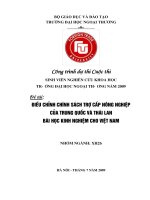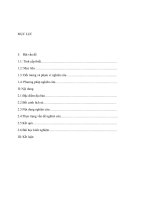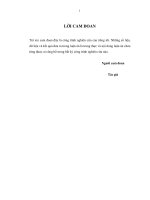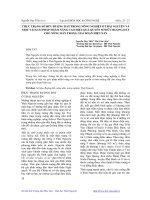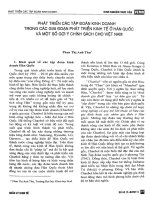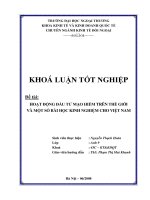Báo cáo nông nghiệp:" Bảo hiểm nông nghiệp ở Nhật Bản và một vài gợi ý chính sách cho Việt Nam" pptx
Bạn đang xem bản rút gọn của tài liệu. Xem và tải ngay bản đầy đủ của tài liệu tại đây (219.84 KB, 10 trang )
J. Sci. Dev. 2011, 9 (Eng.Iss. 1): 91 - 100 HANOI UNIVERSITY OF AGRICULTURE
Agricultural Insurance in Japan and Policy Implications for Vietnam
Bảo hiểm nông nghiệp ở Nhật Bản và một vài gợi ý chính sách cho Việt Nam
Pham Bao Duong
Faculty of Economics and Rural Development, Hanoi University of Agriculture
Corresponding author email:
Received date: 07.07.2010 Accepted date: 27.03.2011
TÓM TẮT
Nhật Bản có một hệ thống bảo hiểm nông nghiệp vận hành khá tốt, được hình thành và phát
triển từ hàng trăm năm nay. Hiện tại, hệ thống bảo hiểm này đóng vai trò quan trọng như là trung tâm
của các giải pháp hỗ trợ của Chính phủ đối với các tổn thất nông sản do thiên tai. Có rất nhiều điểm
tương đồng giữa Nhật Bản và Việt Nam về địa lý trải dài, sản xuất nông nghiệp phần lớn do các hộ
nông dân sản xuất nhỏ thực hiện, canh tác lúa vẫn đóng vai trò quan trọng trong kinh tế nông thôn,
cũng như cấu trúc gắn kết trong cộng đồng làng xã Bên cạnh đó, Nhật Bản và Việt Nam cũng có
những điểm khác biệt căn bản. Thông qua nghiên cứu chuyên sâu, tổng quan kinh nghiệm phát triển
hệ thống bảo hiểm nông nghiệp ở Nhật Bản, nghiên cứu này đề xuất một số gợi ý chính sách đối với
việc thiết lập và phát triển hệ thống bảo hiểm nông nghiệp ở Việt Nam.
Từ khóa: Bảo hiểm nông nghiệp, gợi ý chính sách, nghiên cứu so sánh, Nhật Bản, Việt Nam.
SUMMARY
Japan now possesses a well functioning agricultural insurance scheme as a result of a long
historical process of establishment and development. At present, the scheme plays an important role
as the centerpiece of the central government’s relief measures for losses of agricultural commodities
caused by natural disasters. There are many similarities between Japan and Vietnam with respect to
the geographical location, the domination of small size and rice farming and cohesively structured
villages. Besides, a number of differences between the two can be found as well. By in-depth
reviewing the development of the agriculture system in Japan, this study aims at drawing some policy
implications for the development of the agricultural insurance in Vietnam.
Key words: Agricultural insurance, comparative studies, policy implications, Japan, Vietnam.
1. INTRODUCTION
Risks are pervasive in agriculture. It is
inherently conducted in vast areas of fields and is
much dependent on geographic and weather
conditions. Farmers always face a variety of risks
originated from weather uncertainty, pests and
diseases, and market conditions. Regarding risk
management, a number of measures have been
implemented, of which agricultural insurance is
probably the most important. Agricultural insurance
is an economic institution for management of risks
by farmers. It has the following objectives: (1) to
stabilize farmers’ income by reducing adverse
effects resulting from substantial losses due to
natural hazards, i.e., to save farmers from financial
disasters arising from crop failure; (2) to encourage
risk-averse farmers to adopt improved technologies
91
Agricultural Insurance in Japan and Policy Implications for Vietnam
which can lead to increased production and more
efficient use of resources; and (3) to reduce the risk
for credit agencies, so as to help farmers having
better credit rating for the purpose of loan, which
can result in increased flow of credit to farmers
(Mishra, 1999).
Given the well-known benefits of agricultural
insurance, many attempts have been made for years
in a number of countries to establish and develop
an agricultural insurance scheme. In Japan, the
current scheme is a result of a long historical
process of establishment and development. It is
now indispensable for Japanese farmers because
their agriculture frequently suffers from heavy
losses caused by typhoons, floods, low temperature,
and other meteorological events. Farmers
significantly benefit from the scheme simply
because it has worked fairly well, catering to the
farming communities.
Agricultural insurance would have had a
particular salience in the context of Vietnamese
rural development. Agricultural production plays a
crucially important role in Vietnamese economy
where approximately 80 % of the population live in
rural areas with their main source of income
derived from agriculture. The country, however, is
long spread out over many parallels of latitude,
covering many different bio-geographic regions.
Farmers often suffer from natural calamities such
as typhoons, floods, drought and so on with severe
damages. Furthermore, they are equally small in
terms of landholdings although there exist some
variations among regions. Given the said
characteristics of Vietnamese agriculture, it is
expected that agricultural insurance should have
had much room to play in Vietnam.
The objectives of the paper are (1) to make a
study on agricultural insurance in Japan and (2) to
draw policy implications for Vietnamese
agriculture. It is worth noting in advance that this
paper will not go into analyzing in-depth the
management and operation of programs in Japanese
agricultural insurance scheme. Instead, this study
aims at pointing out basic features of the scheme
and drawing a set of relevant implications for the
establishment of a scheme in Vietnam.
This article is structured as follows. After the
introductory part, the paper reviews dominant
features of Japanese agriculture. It follows the
discussions concerning salient features of the
Japanese Agricultural Insurance Scheme. Part 4
mentions policy implications in which it starts with
comparative studies between Vietnamese and
Japanese agriculture followed by some proposed
policy implications to Vietnam. Concluding
remarks are placed at the end of the paper.
This is an in-depth literature review on the
development of Japanese insurance scheme and its
implications to Vietnam. Hence, methodologically,
this paper employs a comparative study method and
builds on a number of studies on Japanese
agriculture and its insurance scheme.
2. DOMINANT FEATURES OF JAPANESE
AGRICULTURE
Though the share of agricultural GDP is quite
negligible, today, Japanese farmers have become
relatively wealthy. Some of the most dominant
features of Japanese agriculture are as follows.
First, the rural structure has basically been
determined by rice production and paddy fields
(Yurugi, 2001). At the beginning of the 20
th
century, more than half of the GDP was from the
agricultural sector and about half of the agricultural
production was rice. It can be said that rice is a
main product in Japanese agriculture. Beside that
vegetable and livestock production has steadily
increased since the 1950s due to the change in
people’s dietary habits and the diffusion of the
modern transportation system. The demand for
such food has increased gradually.
Secondly, with respect to the agricultural
structure, the land distribution pattern is remarkable
unimodal
1
and stable overtime. The size of
cultivated land per farm household has hardly
changed. Farm size is rather small averaging about
1 ha. The proportion of small farmers below this
mean is always remained at about 70 % (Table 1).
Hayami (1991) showed that this (the small farm
size) is the basic factor limiting Japanese
agricultural productivity
1
A unimodal distribution refers to the case in which most farms are clustered around the mean size (see, Tomich et. al.,
1995).
92
Pham Bao Duong
Table 1. Number and operational size distribution of Japanese farms
Percentage distribution by size class (ha)
Years
Number of farms
(Millions)
<0.5 0.5 - 1 1 - 2 2 - 3 3 - 5 > 5
1908 5.4 37 39 20 6 3 1
1920 5.5 35 33 21 6 3 2
1940 5.4 33 33 25 6 2 1
1960 6.1 38 32 24 4 2 1
1970 5.3 38 30 24 5 2 1
1980 4.7 42 28 21 5 2 2
1985 4.4 43 27 20 6 3 2
Source: Hayami, 1991
Thirdly, most of Japanese farmers are now
part-time farmers. Whereas approximately 30 % of
farm households were engaged in fulltime farming
in 1960, this figure declined to less than 15% in
1988 (0.6 million of full-time farm households in
the total of 4.19 million households). As of 1988,
the per-farm area under cultivation for full-time
farm households was a mere 2.6 ha. Full-time
farmers and type I of part-time farmers
2
account for
large percentages of the total livestock and
greenhouse agricultural production while the other
type II of part-time farmers
3
account for much of
their rice production (Hayami, 1991). By 1986
farming accounted for only 13% of income, with
off-farm income making up nearly two-thirds, and
grants and pensions comprising the remainder.
Even in 1960 farming accounted for only half the
income of farm households, and about two-thirds of
all farm households were part-time (Tomich et. al.,
1995). It implies that the rural economy is
diversified that serves is as basic condition for
pooling risks.
Fourthly, although at the early of the 20
th
century
Japanese agriculture was heavily taxed, however, the
situation is reversed significantly nowadays.
Agriculture is heavily supported and strongly
protected. Hayami (1991) reported that the demand
for price support took the form of pressuring the
government to raise price of rice. The government
predetermined price of rice rose rapidly,
corresponding to the rise in industrial wage.
Furthermore, Japan has a very high rate of agricultural
trade protection. Honma and Hayami (1991) reported
that average nominal rates of protection
4
in recent
years show a high level of agricultural protection in
Japan. In 1987, this rate of Japan stood at 151%.
However, at the same time, it should be noted that
self-sufficient ratio of food is very low. This helps
to maintain social stability in the process of
economic development. There have existed also a
number of subsidy (or supporting) policies to
agriculture of which subsidy to the agricultural
insurance scheme is not exceptional.
Fifthly, Japanese rural communities are of very
solid structure. Yurugi (2001) reported that Japanese
village communities consist of enduring farm
households as manifested by the low mobility of
farm households. People closely watch each other
and a single piece of news could be quickly spread
over a village. It is considered that this system is
very suitable for collaboration works, especially, in
which information plays crucial role such as
insurance. Moreover, Confucianism is deeply rooted
in people’s mind. Tomich et. al., (1995) show
literature that Confucian tradition had “inculcated in
the whole nation habits of discipline and obedience”
with the result that “the most sweeping
transformations were accomplished with relative
ease, because the mass of the people were schooled
in respect for men blessed with courage, trained in
public affairs, and moved by a high sense of duty”.
The importance of Confucianism on the individual’s
capacity for self-improvement in fostering attitudes
conducive to economic progress is strongly stressed.
Furthermore, it is also argued that because of
Confucianism and other influences on family
structure “socialization, within Japanese family,
inculcated in many Japanese a type of self-motivated
achievement orientation” that “made it possible to
adequately man the operation of the society…”.
2
Type I of part-time farmers refers to those whose majority of income are from farming
3
Type II of part-time farmers refers to those whose majority of income are from non-agriculture
4
The nominal rate of protection is defined as the ratio of the difference between domestic and border prices to
the border prices.
93
Agricultural Insurance in Japan and Policy Implications for Vietnam
3. THE JAPANESE AGRICULTURAL
INSURANCE SCHEME
3.1. Short Overview of the Theory of Agricultural
Insurance
Agricultural insurance is an effective
mechanism for reducing the losses
farmers suffer
due to natural calamities such as floods, droughts,
and outbreaks of pests and diseases. It enables
farmers to obtain credit and financing for investment
in new technologies, tools, and equipment to
enhance and sustain their productive capacity. It also
assists farmers in regulating cash flows and provides
a financial buffer with which to rehabilitate damaged
enterprises. Enhancing the knowledge of those
involved in agricultural insurance from both the
private and public sectors on its principles,
mechanisms, and management is vital.
By definition, insurance is based on the law of
large numbers. It is basically a mechanism of
pooling of risks by a large number of individuals. It
also helps spreading risk over space and time.
Insurability of risk depends in three factors: First, it
should be possible to quantify the probability of the
events that triggers payment of indemnity; second,
there should be substantial independence in the
incidence of such events, otherwise the problem of
covariability will arise; and third, it should be
feasible to attribute and evaluate the damage caused
by the event (Mishra, 1999).
In order to design a scheme of agricultural
insurance one has to keep in view the agricultural
situation, socio-economic factors and
administrative infrastructure. These aspects will
vary from country to country, and even across
various regions of a country. It is, however, useful
to identify certain aspects which need to be
considered while developing and operating
agricultural schemes.
There are some key elements that shape the
superstructure of a scheme. They are important
from the points of view of its effectiveness,
operational viability and sustainability. These are:
1) target farmers; 2) coverage of crops- all or some
crops; 3) insurance coverage, indemnity level and
determination of loss; 4) premium rate and
collection procedure; 5) loss adjustment
mechanisms; 6) organizational structure; 7)
financing of the scheme; 8) reinsurance
arrangement and 9) communication with farmers.
A blueprint of an agricultural insurance
program suited to a particular country needs to be
prepared keeping in view the prevailing situations,
available infrastructure and the socio-economic
framework. Further, agricultural insurance should
not be considered in isolation. It needs to be
integrated with the related activities like
agricultural credit, extension and marketing
infrastructure (Mishra, 1999).
3.2. Salient Features of Japanese Agricultural
Insurance Scheme
It can be said that the current scheme of
agricultural insurance in Japan is a result of a long
historical process of establishment and
development. The government of Japan has
actively redesigned the scheme many times to keep
pace with changing circumstances. Particularly
regarding livestock, in 1949, livestock insurance
became obligatory and the State liability scheme
was introduced to subsidize part of the premium. In
1955, the law was amended to unify death and
disuse insurance and disease and injury insurance.
At the outset, however, most farmers insured only
part of their livestock that resulted in a rapid
increase in the incidence of livestock injuries.
Consequently, in 1966, the above law was revised
to oblige farmers to insure all of their livestock.
Thereafter, the law was revised regularly in 1985 in
accordance with changes.
At present, the scheme plays a very important
role as the centerpiece of the central government’s
relief measures for losses of agricultural
commodities caused by natural disasters (Yoshii,
1999). The main features of the scheme are as
follows: (1) The central government reinsures the
programs; (2) In principle, implementation of three
types of the insurance programs – Rice, wheat, and
barley; sericulture; and livestock insurances – is
compulsory; (3) The central government subsidizes
farmers with part of their premiums; and (4) The
central government subsidizes the insurers with part
of their administrative expenses.
The notable feature is that agricultural
insurance in Japan is based on the local farmers’
cooperative action to establish a joint reserve funds
by accumulating the premiums with a view to
releasing losses suffered by farmers who are
actually hit by natural disasters.
The scheme is structured with the three tiers:
national, prefecture, and village level. The rational
basis for adopting such a structure is that by doing
so, risks can be pooled at a national wide because a
natural disaster often causes extensive damage over
a wide area.
94
Pham Bao Duong
[National Level]
Agricultural Re-reinsurance Special Account
(ARSA)
Re-reinsurance Re-reinsurance
Premiums Indemnities
Reinsurance Reinsurance
Premiums Indemnities
Premiums Indemnities
Figure 1. Organization Chart
The AMRA is established in each municipality
(village) and its members are all the farmers in the
locality. The AMRA is totally responsible for the
operation of the scheme at the lowest level,
particularly in the establishment of mutual contracts,
collection of premiums, estimation of loss as the
basis for payment of indemnities, provision of
technical assistance to farmers especially with
respect to loss prevention. The AMRA is
autonomous. Regarding PFAMRA, it is established
to administer the implementation of crop insurance
in every prefecture. The PFAMRA receives
reinsurance premiums from AMRAs and shares a
part of the insurance responsibility of AMRAs. The
PFAMRA pays re-reinsurance premiums and
transfers a part of its reinsurance responsibility to
the ARSA. Furthermore, PFAMRA provides
guidance with respect to the control of insects and
diseases and loss assessment. Concerning the ARSA,
it reinsures part of the reinsurance responsibility of
the PFAMRA. The ARSA pays re-reinsurance
indemnities to the PFAMRA, when the unusual
damage beyond a certain level occurs.
The relationship between farmer members and
an AMRA is insurance relations while that among
AMRAs, PFAMRAs, and the ARSA are (re)-
reinsurance relations. In other words, farmer
members contribute insurance premiums to AMRA
and in case of being eligible, they can get
indemnities from AMRA. AMRAs contribute part
of the premiums to PFAMRAs and get a partial
reimbursement for the indemnities paid to farmer
member. The same relationship is established
between PFAMRAs and the ARSA. Whenever a
given contract between a farmer member and an
AMRA is formed, automatically, so are the above
chain relationships.
Covered items: The scheme covers almost all
items in agricultural productions (Table 2). The
programs numbered 1, 2, and 3 are implemented at
the national wide basis because the insurance
covered items are produced nationwide whereas the
rest is optionally applied for particular regions
where products are produced.
[Prefecture Level]
Prefectural Federation of Agricultural
Mutual Relief Associations (PFAMRA)
[Village Level]
Agricultural Mutual Relief Associations
(AMRA)
Member Farmers
95
Agricultural Insurance in Japan and Policy Implications for Vietnam
Table 2. Covered Items
Programs Items which may be insured
1. Rice, Wheat, and Barley Insurance Paddy rice, upland rice, wheat and barley
2. Sericulture Insurance Silk-cocoons
3. Livestock Insurance Cattle, horses, and swine
4. Fruit and Fruit-tree Insurance - Fruits: mandarin oranges, oranges, other citrus fruits,, apples, grapes,
pears, peaches, loquats, cherries, persimmons, chestnuts, ume, plums,
and pineapples.
- Trees of the above listed fruits
5. Field Crop Insurance Potatoes, soybeans, adzuki red beans, kidney beans, sugar beet,
sugarcane, hops and tea plants
6. Greenhouse Insurance Greenhouse, ancillary facilities and plants cultivated in a green house
Source: Yoshii (1999)
Table 3. Government Subsidy Rate to Premiums
Programs Covered items Government Subsidy Rate (%)
1. Rice, Wheat, and Barley Insurance Paddy rice, upland rice
Wheat and barley
50
50-55
2. Sericulture Insurance 50
3. Livestock Insurance Cattle and horses
Swine
50
40
4. Fruit and Fruit-tree Insurance 50
5. Field Crop Insurance 55
6. Greenhouse Insurance 50
Source: Yoshii (1999)
In principle, participation in programs 1, 2,
and 3 is compulsorily required for all farmers with
certain prescribed production scales. The reasons
are (1) to prevent adverse selection, (2) to make
programs viable and (3) because farming style for
items in these programs is similar all around the
country. However, there is no penalty on non-
participants. For other programs, participation is
voluntary, because in each area, there are various
types of farming practices. Farmers can join
insurance programs, which suits their farming style.
Regarding the administration of the
agricultural insurance scheme, it differs program by
program. The key components are underwriting
(including participation, insurable perils, period,
coverage, and premium) and loss assessment
(including loss claim, loss adjustments at various
levels, and payment of indemnity). Detailed
descriptions of the management and operation can
be found in Yoshii (1999) and Sato (1991) for Rice
Insurance and in Kagoshima (1999) and Koyama
(1991) for Livestock Insurance in Japan.
The salient point is that the government
heavily subsidizes the scheme. The subsidy is
mainly the premium subsidy for policyholders and
the grant for office expenses of the insurer
(AMRAs) and the re-insurers (PFAMRAs). The
subsidy rate for premium is about 50% for most of
the programs (Table 3).
The performance of the programs can be
briefed as follows. The participation rate, which is
defined as the proportion of the area of the insured
land to the total area of cultivated land of the
insurable crop concerned, or the proportion of the
total number of heads of the insured livestock to the
total number of heads of the breeding livestock
concerned, remain at a high level, about 90% for
the programs numbered 1, 2, and 3 (exclusive of
swine). On the other hand, the rate for swine
insurance, and the programs numbered 4, 5, and 6,
which adopt the voluntary participation basis,
remains at a low level, i.e., from 14% to 50 %.
Regarding the balance of revenue and expenditure
of the program, the balance of the program 1 is
96
Pham Bao Duong
largely fluctuating, that of program 3 is in the red,
and the rest of programs are generally have a
balance in recent years (Yoshii, 1999).
Generally speaking, the Agricultural Insurance
Scheme in Japan has worked fairly well, catering to
the farming communities with homogeneous
structure, and has fulfilled the objectives (Yoshii,
1999). It is also considered as fairly successful in
view of its long operational existence and viable
operational structure. Factors that explain such
success are: (1) well-balanced government
leadership and spontaneous farmers’ participation,
(2) well-organized social infrastructure, and (3)
continued financial support by the national
government (Kada and Shigeno, 1991). However,
the scheme is seemingly facing problems in which
mostly dominated by the dissatisfaction of both
small-scale and part-time farmers and large-scale
farmers with the present scheme. The former, who
is rice grower, is dependent more on off-farm
income than on-farm income, become reluctant to
participate in the Rice Insurance Program and pay
premium under the compulsory-participation
system. On the other hand, the later, who have good
farming skills, believe that they, compared with
small-scale farmers, always pay higher premium
and receive smaller indemnity.
4. POLICY IMPLICATIONS FOR VIETNAM
4.1. Primarily comparative studies between
Vietnamese and Japanese agriculture
There are similarities between the two in a
number of respects. First, like her counterpart,
Vietnam is long spread out over many parallels of
latitude, covering many different bio-geographic
regions. The country is also frequently hit by
natural calamities resulting in severe damages.
Obviously, agriculture is a prime victim of these
calamities. Secondly, Vietnamese agriculture is
also dominated by the smallness of farm size.
Thought it varies region by region, farm size per
household is rather small ranging from about 0.3 ha
in the North to about 1.2 ha in the South.
Furthermore, farmers are quite homogeneous in
terms of landholdings. Farming units sizes tend to
be concentrated in several median brackets. The
distribution of farming units by farm size is
typically unimodal. The situation, however, is
changing significantly since de factor the land
market is quite active resulting in the overall
downsizing of farms and the rapid increase in the
number of landless as well as households with large
landholdings (Izumida, 2000 and Duong et. al.,
2000). The third similarity between the two is the
fact that rice farming is very dominant in both
countries. Although there has been tremendous
diversification away from rice cultivation during
1993 – 1998, however, its share in total agricultural
revenue still stood at 44% in 1998 followed by
livestock and aquaculture (31%). Almost all farm
households cultivate rice (in either paddy rice or
upland rice).
The crucial similarity, however, is that
agricultural households conduct their farming
mostly in cohesively structured villages dominated
by mutual aid traditions and particular behavior
patterns of rural villages. Like Japanese rural
communities, people in a village closely watch each
other and a single piece of news could be quickly
spread over the village. Although differing in
degree, most of Vietnamese people are also
influenced by Confucianism that is believed to
significantly influence people’s disciplines. As will
be seen later, this factor is very important in
designing and implementing an effective and viable
insurance scheme.
However, there are also many crucial
differences between the two. First, Vietnam is a
country with excessive abundant rural labors.
Underemployment was worse in rural than urban
areas. Although underemployment has improved to
some degree, about 60% of rural workers and 40%
of urban worker were still underemployed. Even in
1998, over 10% of the workers fell into a category
of severe underemployment.
The second difference is that whereas most
Japanese farmers are part-time farmers, the
situation is rather reversed for the case of Vietnam
where almost farmers are fulltime farmers. Though
at the national level, diversification is progressing
but most Vietnamese farmers still depend large
income on agriculture, which account for 47% of
household income in 1998. This crucial difference
should be properly taken into account when
designing an agricultural insurance scheme in
Vietnam.
The government of Japan has been heavily
subsidizing agriculture including the its insurance
scheme. As mentioned above, it takes many forms
such as price support or direct grants and so on. It
might be difficult for other developing countries to
replicate this strategy because of the severe
constraint on budgets.
97
Agricultural Insurance in Japan and Policy Implications for Vietnam
And lastly, Vietnamese agriculture is still in an
early stage of development. A large proportion of
production is still for self-consumption. It is in
significant contrast with the Japanese one whereas
commercialization and diversification of agriculture
have reached a very high level. However,
Vietnamese agriculture can bring into play the
advantage of the late comer which took Japan
hundreds of years to develop.
4.2. Implications for Vietnam
Having mentioned about the scheme in Japan
and the primarily comparative studies between the
two countries, the first implication can be drawn is
that by all means, Vietnam should introduce an
agricultural insurance scheme to farmers as the
soonest. Given the particular characteristics of
Vietnamese agriculture, this is an urgent task. It is
so because:
Vietnam is frequently and severely hit by
natural calamities, Vietnamese farmers are small in
terms of farming size and homogeneously
vulnerable to these adverse shocks. Therefore,
insurance would be an effective measure to smooth
extremely income fluctuations for them, especially
the poor. Insurance is also expected to be an
effective and equitable in channeling supports from
the government to farmers.
It is crucial to improve Vietnamese
agricultural productivity to enhance the income of
rural households. Agricultural diversification is an
option. This is necessary but not sufficient
condition. The sufficient one is that the whole rural
economic structure needs to be entirely
transformed. Whether farmers – the autonomous
economic units - would be able to shift their
traditional, conventional farming practices, crops,
livestock toward the ones with high commercial
values and competitiveness depend largely on their
behaviors toward risks. In order to encourage
farmers to take good risk projects, risks of such
shiftings need to be insured effectively through an
insurance system. The authors believe that only by
this way it can keep Vietnamese agriculture
continuing to grow in the future.
Currently, formal financial institutions in
Vietnam are facing great difficulties in extending
loans to rural households largely because of the
difficulties in accessing the credit worthiness of
potential clients. Credit demands from rural
households are still strong. If agricultural
production is insured, it will surely be helpful to
financial institutions to play a greater role. In fact,
finance and insurance are two aspects of one issue
that is to ease liquidity shocks (constraints) for
households.
Secondly, the establishment of the agricultural
insurance scheme in Vietnam is repeatedly and
doubtlessly the urgent task. However, the scheme
should not be hastily introduced since the failure of
an unfortunately unsuccessful one would causes
pervasive consequences. It will be better for
Vietnam to take a gradualist approach, i.e., to
conduct step by step in designing the relevant
scheme. Some experimental programs could be
implemented first followed by summing up and
further expansions. If it took tens of years for Japan
to follow the recommendations from German
consultants, then for Vietnam with the advantages
of a late comer, some years for establishing and
building up the scheme would be reasonable.
Thirdly, besides factors mentioned above, the
success of Japanese scheme is also, to the authors’
understanding, decisively attributed by the
thorough design and active amendments to keep
pace with changing circumstances. The salient
point is that the scheme has been designed to fit the
particular characteristics of Japanese agriculture.
The scheme was emerged because of demand of
farm households. Therefore, the strong message is
that the careful designing of the scheme is crucial.
When designing the scheme, the following points
could be taken into account as references:
1. The spirit of mutual cooperation in localities
has firstly to stress throughout. Insurance,
especially for agriculture, is a business in which
much information is required. Japanese scheme has
fully utilized the unique factor of solidarity and
mutual helps of the villages. Like Japan,
Vietnamese rural communities are also dominated
by this factor.
2. Japan has adopted the agricultural insurance
structured by three tiers. The question is how many
tiers should Vietnam structure in her scheme.
Vietnam has four administrative level, namely,
national, provincial, district, and commune. To the
authors, Vietnamese agricultural insurance should
be implemented at the national wide to disperse
risks across the country and downed to the
grassroots level of commune to exploit the
economics of information. The open question is
whether Vietnam should have either or both
provincial and/or district federation of agricultural
insurance?
98
Pham Bao Duong
3. Agriculture is inherently characterized by
covariant risks, which occur in vast areas.
Sometimes a loss from a natural calamity is so huge
that any single entity cannot afford. In case of an
extraordinary shock, the government should be
responsible for payment of indemnity. The
systematic relationships among tiers which are
insurance relationship or (re)reinsurance
relationship in Japan may be well applicable to
Vietnam as well.
4. Vietnam has many types of agricultural
products. Of which how many should be covered
by insurance national wide and which products are
covered by regional insurance programs. From
Japanese experience, the key issue is to identify
where a product is produced in order to design
effective insurance programs.
5. The next issue is whether participation in a
particular insurance program is based on
compulsory or voluntary basis. Compulsory
participation would ease the scheme to avoid
adverse selection problem. At this point, the
consensus among participants is critical. In a
subsector characterized by homogeneity in terms of
farming practices as well as production scale,
compulsory participation may be preferred.
6. Due attentions should be given to
management and operation of the scheme,
especially at the commune level. Insurance officers
must be well trained for managerial skills in
underwriting and loss assessment. The actual
performance of the AMRAs in Japan shows that
these skills are crucially important to ensure the
smooth functioning of the scheme.
7. One factor contributing to the successful
performance of Japanese scheme is the continued
financial support by the national government for
premium as well as administrative costs of the
scheme. The authors’ point of view is that the
scheme must be viable financially and sustainably.
Therefore, too much and continuous support from
government may not be sought. However, start-up
supports are really desirable to ease difficulties
facing scheme at days of commencement. The
supports from government can be in other forms
such as research, development, and so on.
8. The insurance scheme should be placed in
close complimentary with rural financial system as
well as agricultural extension system. The well
performing of each is likely much contributed by
other as well.
5. CONCLUDING REMARKS
Agriculture plays an important role in
Vietnam. However, due to an unique geographical
location, infrastructure, production technologies
and other conditions, risks are still quite pervasive
in the sector that directly affect to production and
livelihood of millions of farm households as well as
to national socio-economic stability and
development.
The government of Vietnam has made several
attempts to develop the agricultural insurance
scheme to address the problem. Due to specific
nature of insurance services in the agricultural
sector, it is necessary to learn experiences from
other countries when designing the scheme. With
many similarities (and dissimilarities) compared to
Japanese counterpart, hence, it is worth studying
the developmental experiences of the agricultural
insurance system in Japan and drawing the own
implications to Vietnam. The results show that the
system has been quite developed for a century with
the strong supports from Japanese government. The
comparative studies reveal that it seems urgent to
establish a similar system in Vietnam now. In order
to ensure the sustainable operation of the future
system in Vietnam, several critical issues are noted
at the end of the paper.
REFERENCES
Hayami Yujiro (1991). Institutional aspects of
Agricultural Development in Yujiro Hayami and
Saburo Yamada (Ed.), The Agricultural
Development of Japan: a Century’s Perspective,
University of Tokyo Press, Japan.
Honma Masayoshi and Hayami Yujiro (1991).
Causes of Growth in Agricultural Protection in
Yujiro Hayami and Saburo Yamada (Ed.), The
Agricultural Development of Japan: a Century’s
Perspective, University of Tokyo Press, Japan.
Izumida Yoichi (2000). Agricultural Structure
Problems in Vietnam, Working Paper Series,
No. 00-F-002, Department of Agricultural and
Resource Economics (DARE), The University of
Tokyo, Japan.
Kada Ryohei and Shigeno Ryuichi (1991).
Planning and Practices of Agricultural
Insurance: Theoretical Approach in Agricultural
Insurance in Asia: Planning and Practices, Asian
Productivity Organization (ed.), Tokyo, Japan,.
99
Agricultural Insurance in Japan and Policy Implications for Vietnam
Kagoshima Keisuke (1999). Livestock Insurance in
Japan in Development and Operation of
Agricultural Insurance Schemes in Asia, Asian
Productivity Organization (ed.), Tokyo, Japan.
Koyama Yoshinobu (1991). Livestock Insurance in
Japan in Agricultural Insurance in Asia:
Planning and Practices, Asian Productivity
Organization (ed.), Tokyo, Japan.
Mishra Pramod K. (1999). Planning for the
Development and Operation of Agricultural
Insurance Schemes in Development and Operation
of Agricultural Insurance Schemes in Asia, Asian
Productivity Organization (ed.), Tokyo, Japan.
Pham Bao Duong, Tomohisa Sato, Seiji Shindo and
Yoichi Izumida (2000). Microanalysis on the
Vietnamese Agricultural Structure Result of the
field survey in Ninh Binh and An Giang
provinces, Working Paper Series, No. 00-F-005,
DARE, The University of Tokyo, Japan.
Sato Norifumi (1991). Operation of Agricultural
Insurance in Japan in Agricultural Insurance in
Asia: Planning and Practices, Asian Productivity
Organization (ed.), Tokyo, Japan.
Tomich Thomas P., Peter Kilby and Bruce F.
Johnston (1995). Transforming Agrarian
Economies - Opportunities Seized, Opportunities
Missed, Cornell University Press, Ithaca and
London.
Yamauchi Toyoji (1987). Development of
Agricultural Insurance in Japan, in Crop
Insurance in Asia, Asian Productivity
Organization (ed.), Tokyo, Japan.
Yoshii Kunihisa (1999). Agricultural Insurance
System in Japan in Development and Operation
of Agricultural Insurance Schemes in Asia,
Asian Productivity Organization (ed.), Tokyo,
Japan.
Yurugi Takao (2001). Experiences with Micro-
credit in Japan: Focusing Rural Credit
Cooperatives between 1900 and 1940, a paper
presented at the Asian Productivity Organization
meeting, Dacca, Bangladesh.
100
